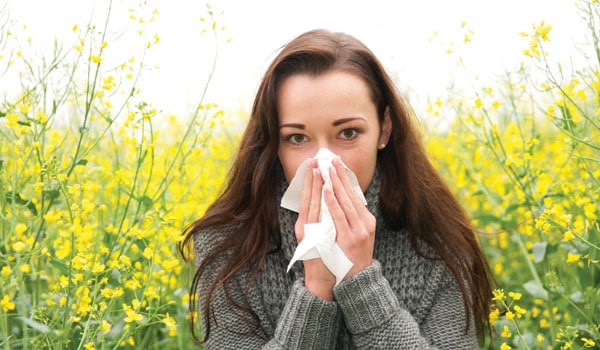Kate Miller takes a look at the increasingly common problem of allergies and the need for continued consumer education
The news in January that Cambridge researchers had made a potential breakthrough in finding a cure for peanut allergy was greeted, by health practi-tioners and the public alike, with a general sense of relief. Little wonder when consider-ing the enormous burden that the huge rise in people affected by allergies has had in the last 50 or so years. Quite apart from the personal impact of living with a potentially life-threatening and debilitating condition, the financial burden on the NHS is enormous, with estimates on the impact on secondary care at around £80 million per year (excluding prescriptions). And for those living with these conditions, the impact is immeasurable, affecting every area of their lives. A 2007 report by the Select Committee on Science and Technology stated that the increasing prevalence of asthma started in the mid-50s and doubled every 14 years until the mid-1990s, with similar increasing figures for other allergies such as hay fever and eczema. The report states: “In 2004 the scale of the ‘allergy epidemic’ became apparent: 39% of children and 30% of adults had been diagnosed with one or more of asthma, eczema and hay fever and 38% of children and 45% of adults had experienced symptoms of these disorder in the preceding 12 months.” By the end of 2005 one in nine people had been diagnosed with an allergic disease. Today the figure for people reporting to suffer from at least one allergy is estimated to be around four in ten (source: Mintel), with half of these suffering from more than one allergy. However, such is the confusion between allergy, intolerance and sensitivity, this figure may be misleading as while half of those reporting allergies have been diagnosed by a medical professional, one in five are self-diagnosed.
Define the difference
Lorna Driver-Davies, a nutri-tional therapist at Nutri-Centre, says that, in a lot of people’s heads, the word allergy is interchangeable with intolerance and sensitivity: “It seems to be a catch-all and it’s further confused by the fact that in America they use the word to mean both an allergy and an intolerance. Anyone watching American TV will hear people referring to their allergies all the time when they mean something different. I spend a lot of time defining the difference with customers.” Marcus Webb, technical director at Hadley Wood Healthcare, agrees: “There is huge confusion; in one conversation people often say ‘I’m allergic to this’ and ‘I’m sensitive to that’ – you have to look at whether you are dealing with an antibody-driven reaction or a chemical-driven sensitivity.” “I definitely think our customers get confused,” says Melanie Ball, owner of Bare Health in Congleton. “They often label themselves prior to having any discussions with a healthcare professional or practitioner, or have been to see their GP and made no headway in resolving their problem. At the other end of the scale we see people who have taken steps, have been diagnosed by a professional and are wanting to make dietary changes and seeking natural products and remedies to support their condition. “ The issue is so confused in the public’s mind, that it is almost impossible to look at the topic of allergies without discussing intolerances too. An allergy occurs when a person’s immune system reacts to a normally harmless substance (which can be inhaled, touched or eaten) known as an allergen. In an allergic reaction white blood cells called mast cells become excessively activated by the antibody Immunoglobulin E (IgE) resulting in an inflammatory response. This can be mild, such as a runny nose or itchy eyes as with hay fever, but can also run through to life-threatening anaphylactic shock. Allergies can be diagnosed by a skin prick test, a blood test or oral food challenging. There is a strong genetic link with allergies, but while the tendency for allergy may be passed on to children of allergic parents, the specific allergic reaction may not be.
Testing for intolerance
Intolerance and sensitivity is a slightly different kettle of fish, and one where mainstream and complementary health-care take different paths. A clue as to why can be found in another name for intolerance which is non-IgE mediated hypersensitivity. Whereas, an allergy involves the IgE antibodies, intolerances don’t. Therefore, according to main-stream medicine, there is no effective test for intolerance. Tests for raised IgG antibody levels produced by the immune system in response to external proteins are available, but divide opinion. On the one hand there are those who argue that the presence of elevated levels of IgG antibodies indicates a response to a particular protein and therefore are responsible for the symptoms; on the other hand are those who argue that this type of elevation is just a normal response and not indicative of anything untoward. Webb, an advocate of the IgG theory and testing, says that the issue is complicated: “Food-related allergic and sensitivity problems occur because of an antibody interaction with proteins contained in the trigger food. The classic example is gluten allergy whereby a person has a severe allergy to the wheat protein gluten. This illness can have serious complications and is a true allergy driven by IgE antibodies. On the other hand one can be sensitive to wheat (testing negative for IgE antibodies to gluten) with elevated IgG antibodies directed towards wheat. This may be associated with an aggravation of less severe health issues such as eczema, rhinitis, migraine and IBS … However, the IgG test can throw false positives since you naturally make antibodies to food constituents, and the more you eat of a food the more antibodies you may make. The problem lies in the fact that just because you make a lot of IgG antibodies to a food, this doesn’t always mean that avoiding that food will improve the health problem, unlike with true allergy. This inconsistency has triggered controversy over the use of food sensitivity testing in the past but if it’s used correctly and the results are interpreted just as one component of a treatment plan then I feel it still has a lot to offer.” The differences between allergies and intolerances are also marked by the reaction time to the trigger, which tends to be rapid in allergies but slower, more unpredict-able and varied in intolerance and sensitivity. And whereas with allergies affected indivi-duals can’t usually tolerate even the smallest amount of the allergen, in intolerances, people can sometimes put up with a small amount without symptoms. A response to an allergy will be marked by certain known symptoms (sneezing, runny nose, itchiness, etc), but responses to intolerances can range from fatigue and joint pains to dark circles under the eyes, eczema and IBS. Intolerances are also a lot more prevalent than allergies – so the chances are that a customers in your store referring to an allergy may, in fact, mean that they have an intolerance or sensitivity. A further area of difficulty and some controversy is multiple chemical sensitivity. Often referred to as 21st Century disease, it’s still not a recognised illness in the UK but causes sufferers often debilitating problems. Says Dr Robert Verkerk, executive and scientific director of the Alliance for Natural Health: “It’s a chemical sensitivity linked to an increased chemi-cal burden which we didn’t have from an evolutionary perspective. Some people suffer more than others and that’s one of the reasons why the mainstream doesn’t get it, as it’s used to looking at population averages.
A different path
Because of the lack of NHS testing for anything other than allergies, and the confusing list of symptoms, people with intolerances and sensitivities have often found themselves let down by mainstream medicine. While medical practitioners are not taught to identify allergies, even fewer are taught about intolerances. Therefore, many people find themselves taking the comple-mentary health pathway. This is good news for health stores, says Dr Marilyn Glenville, who’s book Natural Solutions to IBS explores the theory that a leaky gut is the key to so many of these problems. “The health store is the natural place for people with these problems to go. Retailers should be thinking about the foods that are really causing people problems, like wheat and dairy, and making a feature of what they offer. Food Allergy Awareness Week (from 28 April) is a good time to make the public more aware that they have a lot to offer.” Melanie Ball says that, as it is sometimes difficult to ascertain whether someone has a true allergy or an intolerance, and the extent to which they are affected, the shop suggests they see a nutritionist or complementary practitioner or somebody specialized in food intolerance and sensitivity According to Verkerk, this is good practice: “Given that symptoms of allergy or intolerance are of a medical nature, it is important that a suitably qualified and experienced person evaluates the situation properly and then offers the most appropriate solutions. A health store is actually a much better place for a sufferer to be than a GP’s clinic, because there are typically plenty of non-allergen or intolerance-inducing foods available, and plenty of remedies to help support the immune system and the body’s innate detoxification systems.” Web agrees that having good relations with local holistic health professionals is always a good move. “Letting them know what specialist foods and lifestyle products the store carries will help them direct their patients to the store. Consider a small discount offered to patients sent to the store from local therapists … it all helps generate locality and a sense of community.” Ball says that before recommending products she finds out about an individual’s diet and lifestyle, as making changes here can often bring about great improvements. “I don’t think there is one remedy that ‘fits all’ – each case is unique. Symptoms and conditions are broad. However, for skin complaints we have had a lot of great feedback about the Salcura products and Hopes Relief. Udo’s Choice Oil has been used by customers with skin allergies to good effect. Pycnogenol has also been effective, especially in cases of seasonal allergies. Homeopathic reme-dies are recommended too – we have an experienced homeopath based at Bare Health who works on the clients ‘constitution’. A holistic approach that attempts to identify and treat the underlying cause of a customers problem always seems to get the best results, finding the right products is a part of that process.” Webb suggests quercetin as a good natural antihista-mine, OptiMSM and immune modulator Beta 1,3 Glucan. Verkerk says products that are helpful include gluten- and dairy-free products, prebiotics and probiotics, beta glucans, folate and other B vitamins, vitamin D3, curcumin, resveratrol and a host of herbs, including butterbur and goldenseal. However, he warns: “Some foods that people think are healthy can be a real problem for those with sensitivities. For instance dried apricots – the more orange ones – can be very rich in sulphites which are a big trigger.”
Reasons to be tearful
The hygiene hypothesis
First put forward in the 1980s this theory suggests that the immune systems of children are being weakened by living in too sterile an environment. The theory goes that, when not exposed to enough pathogens, the immune system will attack harmless antigens. This would seem to be supported by data which shows that children born into larger families, where infection is more prevalent, are less likely to have allergic diseases such as hay fever or eczema. Some research has also shown that bowel flora in people living in under-developed countries is possibly allergy-protective. Other studies found that probiotics reduce the development of atopic eczema (source: House of Lords, Science & Technology – Sixth Report). Further evidence found that, following the unification of Germany, allergy rates in the poorer children from the East side, previous lower than the West, rose markedly.
Delivery
Also related to the hygiene hypothesis is the issue of vaginal vs. Caesarean-section deliveries, the latter having dramatically increased in frequency. Verkerk says: “A solid body of evidence now shows that the development of the mucosal immune system is adversely impacted in babies born by C-section, as we are dependent on receiving a dose of inoculum from our mothers during our passage from the sterile uterine environment to the outside world.”
Diet
Diet in pregnancy has long been known to have a potential impact on the health of the newborn, however studies have shown that nutrients such as vitamin E and D and zinc could hold allergy-protective properties for children. Increased risk of asthma has been linked to a lack of fruit, vegetables, fish, butter, dairy fat, anti-oxidants, magnesium and n-3 fatty acids. Add to this the prevalence of wheat in our diets, which has risen dramatically in the last 50 years, processed food rich in gluten and dairy, and you have a dietary intake which evolution hasn’t prepared the body for. Nutritionist Lorner Driver-Davies says that as well as eating less fruit and vegetables, we’re eating them before they’re ripe which is having a huge impact on nutrient intake: “The problem is that fruit is picked too early, so that the glyconutrient process hasn’t taken place. When you meet people who say that they eat loads of fresh fruit and vegetables, you have to ask where they got it from. Fruit ripened under supermarket lighting is no good.”
Pollution and chemical exposure
According to Verkerk, the important point to remember when looking at allergies and sensitivities is that we’ve always had these genetic mutations but we haven’t always had the chemical burden. “Our chemical load increases each day as we are exposed to more than 20,000 chemicals every day,” he says.
Hot Stocks
Be prepared for hayfever
Unbeelievable Bee Prepared Daily Defence and Max Strength Immune Support products with bee propolis help boost immunity and also contains ingredients with natural anti-histamine properties, such as elder- berry which is loaded with quercetin, a top natural remedy for hay fever.
Max solution
Organic HayMax balm, which is applied to the rim of the nostrils to reduce dust and pet allergens, has been found to prevent more than a third of pollen from entering the body – and if there is less allergen in the body, there’s less for the body to react against.
I should Koko Koko
Dairy Free offers a range of dairy-free drinks made from freshly pressed coconut milk sourced direct from its farm in East Sumatra, Indonesia. The range consists of Original + Calcium (chilled and long-life) plus long-life Chocolate and Strawberry options.
The homeopathic route
Dry Skin & Eczema Relief Oromucosal Spray is a homeopathic remedy from Weleda for the symptomatic relief of dry skin and eczema. Weleda also offers a Hayfever Kit containing Mixed Pollen 30C and Rhinodoron Nasal Spray. Nelsons Pollenna contains a 6c homeopathic potency of Allium cepa, Euphrasia officinalis, and Sabadilla officinarum to provide a soothing relief from the symptoms of hay fever and similar allergies by stimulating the body’s own natural healing process.
Allergy Listings
 Moo Free Chocolates
Moo Free Chocolates
Moo Free Ltd,
Tel: 0845 094 6498 Fax: 0118 324 4441
E-mail: [email protected]
www.moofreechocolates.com
Moo Free is a world leading manufacturer of organic dairy free, gluten free and vegan confectionery products that actually taste like milk chocolate. To achieve this they have replaced the cows milk with rice milk to create a delicious, milk chocolate taste that doesn’t require a single cow. Their comprehensive range includes large and small chocolates bar, bags of drops, boxes of chocolates as well as seasonal products such as Advent calendars and Easter eggs. For more information about Moo Free and their product range take a look at their website www.moofreechocolates.com.
 Koko Dairy Free Original + Calcium 1L
Koko Dairy Free Original + Calcium 1L
Koko Dairy Free,
Tel: 01564731980 Fax: 01527831904
E-mail: [email protected]
www.kokodairyfree.com
Allergy Free dairy free milk. Choosing an alternative to cow’s milk can still leave you exposed to the risk of other allergens. But being made from coconut milk Koko Dairy Free is completely allergen free – no dairy, no soya, and no gluten. And, despite the name, a ‘coconut’ is actually classed as a fruit, so it’s nut free too. With a fresh, light flavour Koko Dairy Free tastes remarkably like cow’s milk on breakfast cereals and can be added to tea & coffee without curdling. It also functions like cow’s milk in cooking and baking, allowing allergy sufferers to enjoy a full and varied diet.
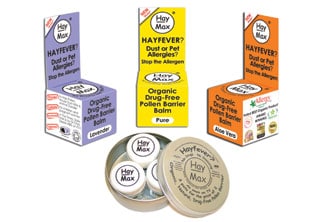 HayMaxTM Allergen Barrier Balms
HayMaxTM Allergen Barrier Balms
HayMaxTM Ltd
Tel: 01525 406600
E-mail: [email protected]
HayMax.biz
HayMax organic allergen barrier balms have been helping allergy sufferers trap pollen, dust and pet dander for almost a decade. Being 100% drug free and non-drowsy makes HayMax popular amongst pregnant and breastfeeding women, and parents love it for their children. The principle is simple – prevention, not cure (less allergen, less reaction). The 2014 advertising and PR campaigns will be the biggest yet, with TV, radio and lots of national press. HayMax has won 27 awards, including platinum awards from natural products advocate Janey Lee Grace. Offers throughout spring and summer. Take a look at our brand new website!
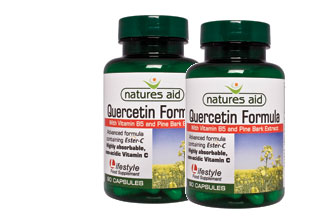 Quercetin Formula
Quercetin Formula
Natures Aid
Tel: 01772 686231
E-mail: [email protected]
www.naturesaid.co.uk
The rise in reactions to airborne allergens has several possible explanations with declining levels of nutrients and increased levels of these airborne allergens being two of the most obvious ones. Sensitivity to allergens can predispose the individual to breathing difficulties, wider sensitivities and skin irritation. The key to reducing the severity of such reactions lies in minimising allergen levels in the bloodstream and buffering the response to them. To support individuals affected, Natures Aid have formulated Quercetin Formula which contains Quercetin, MSM, Ester-C®, Liquorice, Pine Bark and Vitamin B5. 90 capsules RSP £15.95.
 Allergy®
Allergy®
HealthAid Ltd,
Tel: 020 8426 3400 Fax: 020 8426 3434
E-mail: [email protected]
www.HealthAid.co.uk
Boost your body’s immune system. Allergies are versatile. They can show up just about anywhere in your body and create an incredible variety of symptoms. This often leads to physical and emotional distress. Allergforte contains natural antioxidants antihistamines and anti-inflammatories that can help with the symptoms of allergies, its unique formulation containing natural essential ingredients such as Vitamin C, Quercetin and Bromelain, helps to combat the misery of common allergies and make the condition more bearable. Allergyforte is suitable for vegans and vegetarians. Allergforte, retails at £9.99 for 60 tablets. Contact HealthAid Ltd on 020 8426 3400 for purchase and stockist information or visit www.healthaid.co.uk
 Naturtint Reflex
Naturtint Reflex
Nature’s Dream Ltd
Tel: 0845 601 8129 Fax: 01889 507576
E-mail: [email protected]
www.naturesdream.co.uk
Naturtint Reflex is a popular non-permanent colourant that offers a less chemical alternative to permanent hair dyes. Free from ammonia, resorcinol, parabens and peroxide, Naturtint Reflex is also free from PPD meaning it may be suitable for your skin sensitive or ingredient discerning customers. Available in 6 fabulous shades ranging from Black to Golden Blonde, Naturtint Reflex covers the early signs of grey and lasts from 2-4 weeks. With customers becoming increasingly aware of the ingredients used in hair dyes, are you offering them this essential alternative to permanent hair colorants? RRP £9.99
 Quercetin B5 Plus Complex Veg Caps
Quercetin B5 Plus Complex Veg Caps
Viridian Nutrition Ltd,
Tel: 01327 878050 Fax: 01327 878335
E-mail: [email protected]
www.viridian-nutrition.com
Quercetin B5 Plus Complex Veg Caps from Viridian Nutrition is a functional combination of the bioflavanoid Quercetin with the addition of Vitamin B5, Nettle leaf extract, Pine bark extract, Chamomile flower, buffered Vitamin C, Bromelain and Acerola fruit – ingredients which have application year-round, but are especially popular in the Spring when nature is blooming. Seasonal special offer now available to stockists, together with attractive POS. Viridian Nutrition is an award-winning company with more than 180 nutritional products. With experienced sales, marketing and technical expertise, Viridian is dedicated to the security and future development of the specialist health food store.
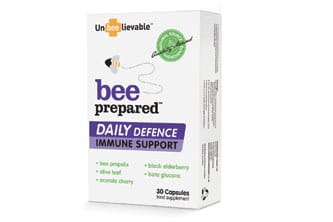 Bee Prepared immune support daily defence
Bee Prepared immune support daily defence
Unbeelievable Health
Tel: 02079 932471
E-mail: [email protected]
www.unbeelievablehealth.co.uk
Manage hay fever naturally! Modulating the immune system to help reduce histamine response and inflammation is key. Bee prepared immune support contains elderberry (rich in quercetin), bee propolis (significant anti-inflammatory properties) & reishi mushroom (antihistamine actions) and other proven immune boosting nutrients. The Daily Mail hails Bee Prepared the ‘Celebrity It-Vit’ (Gwyneth Paltrow, Emma Forbes & Olympic athlete Victoria Pendelton are amongst fans). Aside from reducing allergy symptoms, a healthy immune system is also helpful for clear skin, muscle recovery and to clear toxins faster during periods of detoxing and dieting. For more info and reviews see: unbeelievablehealth.co.uk
 Dry Skin & Eczema Relief Oromucosal Spray
Dry Skin & Eczema Relief Oromucosal Spray
Weleda UK,
Tel: 0115 944 8200 Fax: 0115 944 8210
E-mail: [email protected]
www.weleda.co.uk
Spray that itch away! Weleda has launched a new homeopathic oral spray for Dry Skin & Eczema Relief (£9.95 20ml). Today 1 in 5 children visiting a homeopath suffers from atopic eczema. Registered within the new NR (National Rules) criteria, this handy spray will ease the discomfort of itchy or flaky patches of skin and soothe the irritation of eczema. The spray contains a 6X potency of the homeopathic remedy Graphites, rhythmically prepared by hand at Weleda using traditional methods, at their Derbyshire manufacturing site where Weleda has a team of skilled pharmacists and dispensers. Suitable for children over 12. Vegetarian.
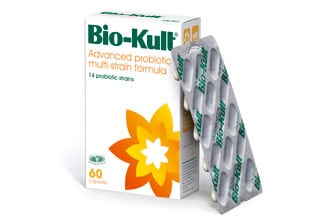 Biokult
Biokult
Probiotics International Ltd (Protexin)
Tel: 01460 243 230 Fax: 01460 249 543
email: [email protected]
www.bio-kult.com
The incidence of allergic diseases is ever increasing, now affecting up to 20% of children in the Western population. It appears that each are often interlinked, with common immune and gut alterations observed. Allergy is said to be a malfunction of the immune system, in which harmless environmental or food substances are interpreted as being harmful, causing the immune system to react incorrectly towards them. First contact can cause elevated levels of allergen specific IgE immune markers (antibodies), primed to remember and overreact in the future. Current treatment is to suppress this immune response with various medications. However, as this is the same defence mechanism the body uses to protect us from truly harmful pathogens, their long term use may not be ideal. The gut mucosal barrier houses approximately 70% of the body’s immune cells, and is lined and influenced by a diverse microflora5. Specific beneficial strains appear to stimulate more regulatory or calming immune cells6. Dysbiosis (imbalanced microflora), or a less diverse range of species, has been observed in those suffering allergic diseases. The use of probiotics could therefore be considered to rebalance the gut flora, modulate the corresponding immune system and to restore a healthy gut lining. Studies are showing positive results of mothers taking probiotics during pregnancy and breastfeeding, with more benefit being seen in prevention opposed to treatment of allergies7. One study halved the risk of infants developing eczema during the first two years of life10. As individual probiotic strains are seen to have specific beneficial effects, a multi-strain probiotic could therefore be considered more effective.


